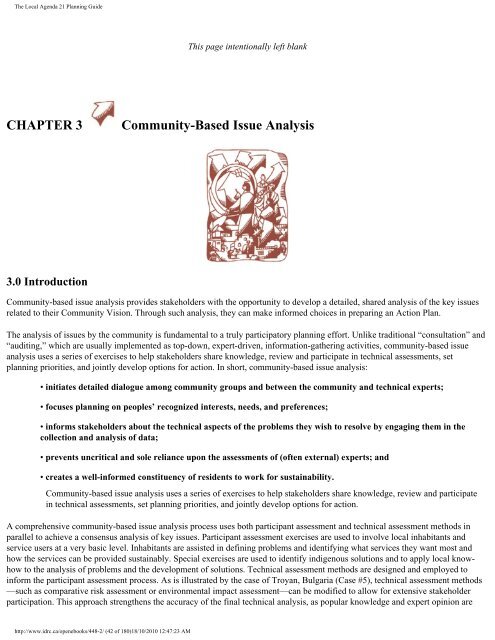The Local Agenda 21 Planning Guide - Democrats Against UN ...
The Local Agenda 21 Planning Guide - Democrats Against UN ...
The Local Agenda 21 Planning Guide - Democrats Against UN ...
Create successful ePaper yourself
Turn your PDF publications into a flip-book with our unique Google optimized e-Paper software.
<strong>The</strong> <strong>Local</strong> <strong>Agenda</strong> <strong>21</strong> <strong>Planning</strong> <strong>Guide</strong><br />
This page intentionally left blank<br />
CHAPTER 3<br />
Community-Based Issue Analysis<br />
3.0 Introduction<br />
Community-based issue analysis provides stakeholders with the opportunity to develop a detailed, shared analysis of the key issues<br />
related to their Community Vision. Through such analysis, they can make informed choices in preparing an Action Plan.<br />
<strong>The</strong> analysis of issues by the community is fundamental to a truly participatory planning effort. Unlike traditional “consultation” and<br />
“auditing,” which are usually implemented as top-down, expert-driven, information-gathering activities, community-based issue<br />
analysis uses a series of exercises to help stakeholders share knowledge, review and participate in technical assessments, set<br />
planning priorities, and jointly develop options for action. In short, community-based issue analysis:<br />
• initiates detailed dialogue among community groups and between the community and technical experts;<br />
• focuses planning on peoples’ recognized interests, needs, and preferences;<br />
• informs stakeholders about the technical aspects of the problems they wish to resolve by engaging them in the<br />
collection and analysis of data;<br />
• prevents uncritical and sole reliance upon the assessments of (often external) experts; and<br />
• creates a well-informed constituency of residents to work for sustainability.<br />
Community-based issue analysis uses a series of exercises to help stakeholders share knowledge, review and participate<br />
in technical assessments, set planning priorities, and jointly develop options for action.<br />
A comprehensive community-based issue analysis process uses both participant assessment and technical assessment methods in<br />
parallel to achieve a consensus analysis of key issues. Participant assessment exercises are used to involve local inhabitants and<br />
service users at a very basic level. Inhabitants are assisted in defining problems and identifying what services they want most and<br />
how the services can be provided sustainably. Special exercises are used to identify indigenous solutions and to apply local knowhow<br />
to the analysis of problems and the development of solutions. Technical assessment methods are designed and employed to<br />
inform the participant assessment process. As is illustrated by the case of Troyan, Bulgaria (Case #5), technical assessment methods<br />
—such as comparative risk assessment or environmental impact assessment—can be modified to allow for extensive stakeholder<br />
participation. This approach strengthens the accuracy of the final technical analysis, as popular knowledge and expert opinion are<br />
http://www.idrc.ca/openebooks/448-2/ (42 of 180)18/10/2010 12:47:23 AM










